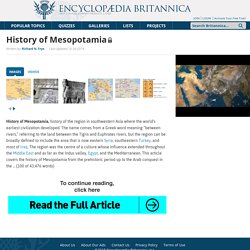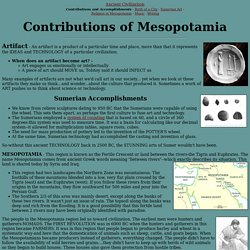Zoom
Trash

TIME-LIFE Mesopotamia: Lost Civilizations (Documentary) HISTORY OF MESOPOTAMIA. Between the rivers: 4500-3100 BC From about 4500 BC there are settlements on the edges of the marshes where the Tigris and the Euphrates reach the Persian Gulf.

Mesopotamia, the region between these two rivers, will be the area of one of the world's first two civilizations, the other being Egypt. Both are established a little earlier than 3100 BC. Unlike Egypt, where a stable society is established along hundreds of miles of the Nile, Mesopotamia will be characterized by constant warfare and a succession of shifting empires. Towns here shelter within thick protective walls. Encyclopedia Britannica. History of Mesopotamia, history of the region in southwestern Asia where the world’s earliest civilization developed.

The name comes from a Greek word meaning “between rivers,” referring to the land between the Tigris and Euphrates rivers, but the region can be broadly defined to include the area that is now eastern Syria, southeastern Turkey, and most of Iraq. The region was the centre of a culture whose influence extended throughout the Middle East and as far as the Indus valley, Egypt, and the Mediterranean. This article covers the history of Mesopotamia from the prehistoric period up to the Arab conquest in the ... (100 of 43,476 words) <ul><li><a href="/EBchecked/media/2341/Sites-associated-with-ancient-Mesopotamian-history? TopicId=376828"><img src=" alt="Mesopotamia, history of" /><span>Sites associated with ancient Mesopotamian history.
The Cuneiform Writing System in Ancient Mesopotamia: Emergence and Evolution. Activity 1.

Why the Fertile Crescent? This first activity will introduce students to the part of the world where writing first developed- the area once called Mesopotamia, which was located in what is today the country of Iraq. Mesopotamia. The Money of Ancient Mesopotamia. Money is used to exchange goods.

If you have something I want, I can offer you money or gold or whatever for it. If you agree that the value is right, you take my money and give me the object. What I give you as money may be either symbolic, valuable, or some combination. In ancient Mesopotamia, what was used as money had a value of its own. Early Dynastic Mesopotamia. Around 2900 BC, after the flood, comes a time period called Early Dynastic, which lasts for about 600 years (there is a good deal of disagreement).

It corresponds to the Old Kingdom in Egypt and to the Early Bronze Age in Greece. The civilization of West Asia continued in more or less the same way as before. Between the Tigris and the Euphrates there were many cities, each laying claim to some of the land around it (and the people who lived on that land). Mesopotamia through Shakespeare. Religion in Ancient Mesopotamia. Religion in Ancient Mesopotamia The people of Mesopotamia were polytheistic and believed that every aspect of their world was controlled by supernatural forces.

The great gods dominated religion in ancient Mesopotamia and many gods maintained their importance throughout the region's history. Cities and kingdoms were believed to be protected by individual gods and it was the duty of the ruler to act on the god's behalf, building temples and performing ceremonies to gain their blessings. Each person had his or her own personal gods (male and female) and smaller shrines have been discovered, for example at Ur, where ordinary people worshipped. Personal gods or major deities and could withdraw their support, which would lead to misfortune for the individual or even the entire kingdom.
From the third millennium BC there is evidence for cult statues. History - Ancient History in depth: Mesopotamia. Mesopotamia - LookLex Encyclopaedia. Mesopotamia's fame in world history relates to it being one of the cradles of civilization, it is by many considered home to the very first civilization in history, predating even Ancient Egypt.

Mesopotamia: Sailboats, Wheels, Cuneiform Writing. Ancient Mesopotamia. Ancient Mesopotamia. Collapse: Mesopotamia. Mesopotamia was known as the land between two rivers, the Tigris to the north and the Euphrates to the south.

Rains were seasonal in this area, which meant that the land flooded in the winter and spring and water was scarce at other times. Farming in the region depended on irrigation from the Tigris and Euphrates Rivers. In ancient times, many resources in Mesopotamia were scarce or absent, which stimulated trade within the region and beyond. Supported by lucrative trade with its neighbors, Mesopotamia grew to become a powerful empire.
Mashkan-shapir was a typical Mesopotamian city, located about 20 miles from the Tigris River and connected to the river by a network of canals. Poisoned fields: A contributor to collapse Along with factors such as war and changes in the environment, scientists now believe irrigation techniques played an important role in Mashkan-shapir's collapse. In Mesopotamia, irrigation was essential for crop production. Could this happen today? Mesopotamia. Ancient Civilization Contributions and Accomplishments - Birth of a City - Sumerian Art - Religion in Mesopotamia - Music - Writing Contributions of Mesopotamia Artifact - An artifact is a product of a particular time and place, more than that it represents the IDEAS and TECHNOLOGY of a particular civilization.

When does an artifact become art? - Art engages us emotionally or intellectually A piece of art should MOVE us, Tolstoy said it should INFECT us Many examples of artifacts are not what we'd call art in our society... yet when we look at these artifacts they make us think...and wonder...about the culture that produced it. Sumerian Accomplishments We know from relieve sculptures dating to 850 BC that the Sumerians were capable of using the wheel.
So-without this ancient TECHNOLOGY back in 2500 BC, the STUNNING arts of Sumer wouldn't have been. Religion of Mesopotamia. Fast Facts About Mesopotamia | Mesopotamian Religion We can only speculate about early religion.

When the ancient cave painters drew animals on the walls of their caves, this may have been part of a belief in the magic of animism. By painting the animal, the animal would appear; by painting it speared, success in the hunt might be guaranteed. Neanderthals buried their dead with objects, presumably so they could be used in the afterlife. Gale - Enter Product Login. Science, Math, and Technology of the Ancient Near East. Science and Technology in Mesopotamia (Mathematics, Astronomy and Astrology, and Medicine)
Mesopotamians are probably best known for invention of writing but their achievements in science and technology correspond to the level of socioeconomic development and are comparable with achievements of modern society. Harsh weather and environmental conditions required artificial irrigation, while construction of irrigation systems and building activities greatly influenced the development of mathematics.